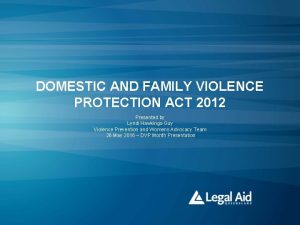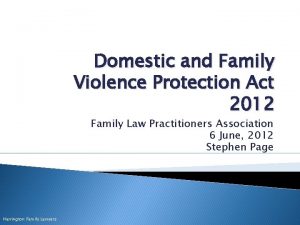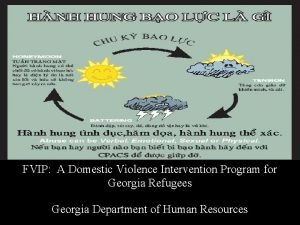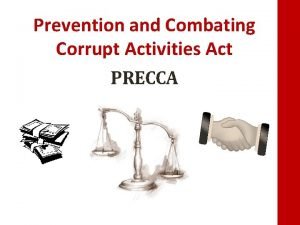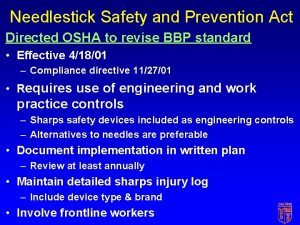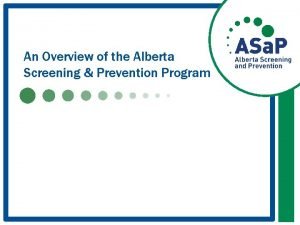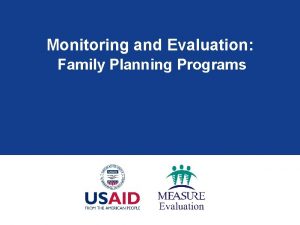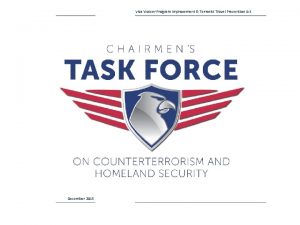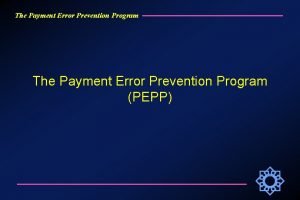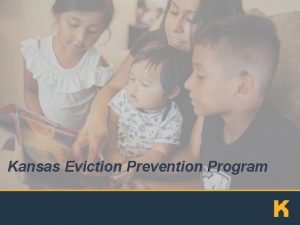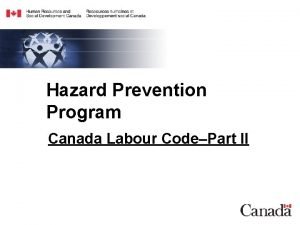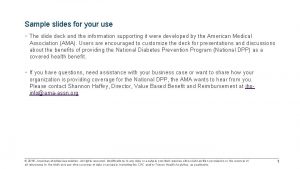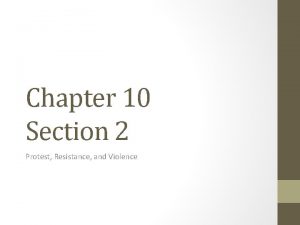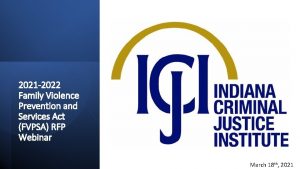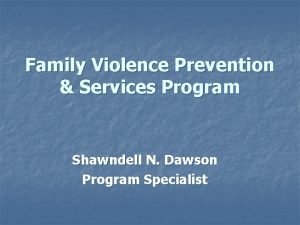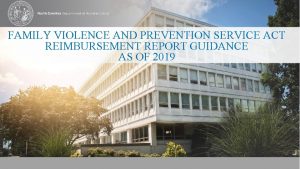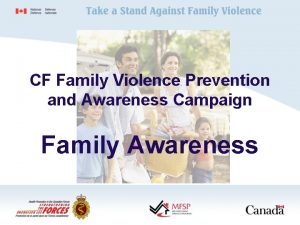Family Violence Prevention and Services Act Program Monitoring






























- Slides: 30

Family Violence Prevention and Services Act Program: Monitoring of Grantees

If you have any questions or feedback, please feel free to type them into the Chat Box at any time. We really want to hear from you!

FVPSA Monitoring of Grantees FVSPA charges the Secretary of the U. S. Department of Health and Human Services with ensuring that there is accountability and transparency of the actions of grantees and contractors. This is accomplished through evaluation and monitoring by FVPSA staff and in collaboration with the Office of Grants Management. 3

Objectives of Grant Monitoring The objectives of the FVPSA Program’s grants monitoring are to: • recognize and document best and promising practices, innovative services, program strengths and significant collaborations. • assess grantees’ level of performance with programmatic requirements including the FVPSA Program’s policy for ensuring accessible services to diverse groups of survivors and diverse communities. • assess grantees’ level of compliance with the administrative and financial requirements of relevant statutes, regulations, policies, and guidelines and/or special conditions applied to a specific award. • verify that programs/projects initiated by grantees are carried out in a manner consistent with the grantee's approved project goals and objectives.

Objectives of Grant Monitoring • promote responsible stewardship of awarded funds by reporting fraud, waste, and abuse, as well as suspected violations, serious irregularities, and sensitive issues. • identify grantees’ technical assistance needs to inform FVPSA-supported training and technical assistance efforts including grantee meetings. • provide guidance or technical assistance to grantees on the FVPSA Program’s policies and procedures, grant program requirements, general federal regulations, and basic programmatic, administrative, and financial reporting requirements. • encourage information sharing between the FVPSA Program and its grantees especially relating to ACF and ACYF priority areas as well as what is happening in the field, including trends in services, shifting funding sources, and challenges and barriers faced by survivors.

Polling Question Has your state undergone a FVPSA Monitoring? A. Yes B. No C. Not sure or unknown

Types of Monitoring Structured Monitoring • In depth review. • In most cases this is conducted through a site visit. • May include the use of a monitoring tool to review specific items for compliance.

Example of Monitoring Tool

Example of Monitoring Tool

Types of Monitoring Additional Types of Monitoring Include: Educational Monitoring For use when the FVPSA Program desires to learn more about the overall mission and purpose of a grantee. In many cases this is conducted through a site visit, but can also be accomplished through a conference call or a meeting at a location other than the grantee’s performance site. Incident Monitoring Occurs when there allegations of policies, practices or services that are in violation of, or in conflict with the conditions of the grantee’s award.

Types of Monitoring Additional Types of Monitoring Include: Maintenance Monitoring Open-ended contact between the FVPSA Program staff and the grantee. It can be used as a follow-up to Structured, Educational or Incident Monitoring. In most cases, it will involve regular reviews of performance through submitted reports, telephone calls, emails and/or other communications. Program or Service Delivery Monitoring Allows FVPSA Program staff to observe grantees engaged in the implementation and/or development of project activities and/or events. In most cases, this can take place through site visits conducted at grantee sponsored activities and events, including but not limited to training and technical assistance to FVPSA grantees, steering committee meetings, roundtables, listening sessions, conferences, etc.

Methods of Monitoring Staff On-Site Visit Involves one or more FVPSA Program staff to visit the grantee’s performance site for the primary purpose of learning about the grantee’s operations, service delivery, policies and practices in the context of its mission and purpose and as they are applied to the activities of their FVPSA Program award. Virtual Site Visit When travel to a grantee is not available, a virtual site visit can be used to conduct the activities that would normally comprise a site visit. Conference calls, Skype, and Webex are possible alternative ways to conduct interviews with the grantee and stakeholders. Peer Review On-Site Visit A type of site visit that involves one or more of the grantee’s peers in the field and includes one or more of the FVPSA Program staff.

Methods of Monitoring Office/Desk Review Involves one or more of the FVPSA Program staff to review the grantee’s financial reports, audit, progress/performance reports, published documents or other products generated using FVPSA funds, and any other subsidiary materials requested in advance. On-going Contact Normally involves on-going contact between the FVPSA Project Officer and the grantee such as through email, telephone or written correspondence. These meetings may discuss the grantee’s implementation and accomplishment of approved activities, meetings, or deliverables. Check-in Contact Periodic contact of the FVPSA Program staff with a grantee normally in response to a previous issue or prior request for technical assistance.

FVPSA Monitoring Targets • At least 10 percent of all active grantees will receive a site visit (Staff, Virtual or Peer Review). The composition of the 10% selected will be determined as part of the annual monitoring plan (i. e. , number of state, coalition, tribal and discretionary grantees). • Active grantees that fall within the Low or Lowest Strength Levels based on results of the Program Strength Assessment will be placed at the top of the Priority List for assistance in determining which grantees should receive site visits. • At least 30 percent of the grantees at the top of the Priority List should have an onsite visit, unless the grantee received an on-site monitoring in the prior year and is progressing in completing any corrective action needed. • When prioritizing grantee site visits, careful consideration is given to ensure that a comprehensive and diverse array of FVPSA grantees receive on-site visits, whether formula, state, tribal, or discretionary award recipients, to reflect the breadth and reach of its statutory purposes.

Program Strength Assessment • The FVPSA Program uses a strengths-based approach, by which use of appreciative inquiry is strongly encouraged, when monitoring grants. • A Program Strength Assessment is performed annually to pro-actively review the strengths of grantees, identify any potential risks to their success, and subsequently to help determine which grantees are in the greatest need of monitoring. • It is one tool in the development of an overall monitoring plan that will include a variety of TYPES and METHODS to be used for monitoring each year. • Knowing this will allow the FVPSA Program to provide appropriate training and technical assistance and help grantees stay focused on the actions that will keep them in compliance with grant requirements.

Program Strength Assessment • The FVPSA Program maintains an Inventory of Potential questions that each team (the Formula Team and the Program Development Team) can select from each year. • This year, there were 6 questions that the Formula Team used to rate the current State Grantees. • The following are 2 of the 6 questions that comprised the Program Strength Assessment for State Grantees that was used to help develop the FY 2019 Monitoring Plan.

Program Strength Assessment for State Grantees 1. Attendance at Required Annual Meeting or Regional Meeting Highest Strength [5]: Current State Administrator attended the last 3 Meetings. High Strength [4]: Current State Administrator attended the last 2 Meetings, but none before. Medium Strength [3]: a) Current State Administrator attended the last Meeting, but none before; OR b) Current State Administrator was not in attendance at the last Meeting; however, he/she sent an authorized representative; AND b 1) Current State Administrator was in attendance in one or more of the Meetings in prior years. Slight Strength [2]: Current State Administrator was not in attendance at the last Meeting; however, he/she sent an authorized representative. Low Strength [1]: a) Current State Administrator was not in attendance at the last Meeting; AND a 1) Did not send an authorized representative.

Program Strength Assessment for State Grantees 1. Performance Progress Report - Timeliness Highest Strength [5]: Has submitted all PPRs on or before the established due date for the past 2 years. High Strength [4]: Has submitted one PPR after the established due date during the past 2 years. Medium Strength [3]: Has submitted more than one PPR after the established due date during the past 2 years Slight Strength [2]: Has submitted a PPR after the established due date during the past 2 years that resulted in the withholding of funds. Low Strength [1]: Has submitted a PPR after the established due date during the past 2 years that resulted in the withholding of funds on two or more occasions.

Site Visit Protocol Pre-Site Visit Preparation (not necessarily in this order) • Review reference materials on hand (e. g. Application; Cooperative Agreement; Financial Reports and Programmatic Reports; and Grant actions and notes in Official Grant File). • Discussion with FVPSA TA providers on any technical assistance provided, interactions or issues, or capacity building recommendations they have provided or experienced with grantee over the past year (as appropriate). • Initiate communication with grantee, schedule site visit, and develop site visit agenda. • Send confirmation letter. • Request documents from grantee for review (will depend upon type of grantee). • Compile Site Visit Materials - determine if Monitoring Tool is required.

Site Visit Protocol Coalitions Documents Requested Prior to Site Review Standard As Needed By-laws Membership Application and Guiding Principles Board Meeting Minutes from prior year Current Board List with Officers Identified Current Staffing list with Job Titles/Organizational Chart Current Membership List with Primary Purpose Service Providers Identified and with any Culturally -Specific Service Providers Identified Strategic Plan Most recent Needs Assessment Employee Handbook/Personnel Manual Operations Policies and Procedures Accounting Policies and Procedures Current Approved Budget 3 most recent months of Approved Financial Statements Last 2 years of Audits

Site Visit Protocol Primary Actions (will vary dependent upon type of monitoring) • Administrative review • Programmatic review • Financial review • Provide Technical Assistance • Exit Interview - Upon completion of the site visit, the FVPSA Program staff should meet informally with the designated grantee official(s) as time permits to discuss: Øpositive aspects of the grantee’s operations and activities Øpreliminary findings Øpreliminary nonbinding suggestions on how to enhance the grantee’s operations Ønext steps, including, possibly, the need to prepare corrective action plans Øchallenges or barriers to effective operations that the grantee wishes to pass along to the review team or to the Family and Youth Services Bureau Øareas in which the grantee could benefit from technical assistance

Example of Activities for a Site Visit to a Coalition and State • • • Joint Meeting with Coalition ED and State Administrator Meeting with Coalition ED and Coalition staff Meeting with Board of Directors or Executive Committee Meeting with SA and State Agency Officials Meeting with Coalition, State and Partnering Agencies in both government and in the community – invite tribal Coalition and tribal programs in the State Tour local domestic violence shelters and/or nonresidential community programs – preferably to include a culturally-specific program Visit a tribal program (if available) Host a Town Hall/Forum with advocates from across the state or limited to specific geographic areas Have dinner with Coalition ED, State Administrator, Tribal Coalition and other targeted stakeholders to foster communication and collaboration

Example of Agenda for a Site Visit focusing on Tribes • Joint Meeting with Coalition ED and State Administrator • Meeting with Coalition ED and Coalition staff • Conduct a Tribal Meeting on Tribal property (if available) for 1 ½ to 2 days ØInvolve NIWR staff and Tribal Coalition staff in the planning and implementation of the meeting ØDevote first part of the meeting solely for tribal representatives and the Tribal Coalition ØBring in the State Coalition and State Administrator into second part of meeting • Visit one or two tribal programs

Example of Agenda for Site Visit focusing on Tribes The purposes for the Tribal Meeting are: • to bring together the tribes in the state to discuss the gaps and barriers in services for survivors of domestic and dating violence and their children. • for the FVPSA Program to listen to the discussion and help facilitate ideas for resources, training and TA as needed. • to foster elevated collaboration between the FVPSA State Administrator, FVPSA State DV Coalition, the Tribal Coalition and the tribes with respect to services for survivors. • to dream about what could be. • to design systems and structures to turn the dreams into reality.

Do you have any questions on what has been presented so far? If your state has undergone a FVPSA monitoring before, what steps did you take to prepare for the monitoring? How much time did you take to prepare for the monitoring?

Site Visit Report The FVPSA Program will send written report to grantee within the timeframe established by each team. This may vary from year to year depending upon the number and timing of the Site Visits; however, the FVPSA Program’s goal is to have reports sent no later than 45 days after completion of the Site Visit. 1. Description of Activities and/or Observations that may include any or all of the following: i. Strengths - noteworthy and positive aspects of the grantee’s program in order to give positive recognition to the grantee for what it does well. ii. Challenges – barriers that the grantee faces in carrying out is grant activities. iii. Best/Promising Practices - may or may not be evidence-based; a method or technique that has shown results superior to those achieved with other means and that other agencies would want to replicate or adopt.

Site Visit Report 2. Findings i. Suggestions for Improvement – non-binding suggestions to promote more effective or efficient operations and to enhance the future development of the grantee’s program. ii. Recommendations that are binding upon the grantee and that the grantee must either respond to with an explanation or remedy under the terms established by the FVPSA Program. iii. Corrective Action Plan in the case where the grantee is determined to be not in substantial compliance.

Not in Substantial Compliance A grantee found to be not in substantial compliance is not providing key services as described in its grant application, the funding opportunity announcement or the statute, regulations or HHS policies. Organizations can also be considered not in substantial compliance if they are using structures or operational plans that are so flawed that consideration must be given to not renewing grant funding unless these conditions are corrected. In such cases, the grantee will be given a written corrective action plan. The corrective action plan will be reviewed and approved by FYSB leadership and other offices as applicable (such as Office of Grants Management or Office of General Council). If the grantee disagrees with the findings of fact reflected in the report and corrective action plan it may submit its concerns in writing within 15 days of receipt. If warranted, the corrective action plan may be revised and resent to the grantee.

Response from Grantee • Statement indicating agreement or disagreement with each recommendation, including reasoning for any disagreement. • A plan for responding to the recommendations that includes: a. Outline of steps or actions b. Timeline for completion of each step or action c. Who will be involved in implementing the steps or actions Once all the responses are approved, the grantee will need to complete the corrective action plan (either the FVPSA provided plan or the grantee’s own plan) and provide documentation to support that completion. After all the steps/actions in the plan are completed, the site visit report will be closed.

Other Webinar Recordings on Monitoring To access the recordings of previous webinars on Monitoring and other resources, you can access them on NNEDV’s private resource library for FVPSA State Administrators at: https: //resources. nnedv. org/groups/17/resources Thank you for your participation today!
 Primary prevention secondary prevention tertiary prevention
Primary prevention secondary prevention tertiary prevention Domestic and family violence protection act 2012
Domestic and family violence protection act 2012 Domestic and family violence protection act 2012
Domestic and family violence protection act 2012 Family violence intervention program atlanta
Family violence intervention program atlanta Adolescent family violence program
Adolescent family violence program Family violence intervention program georgia
Family violence intervention program georgia Routine, universal screening for domestic violence means: *
Routine, universal screening for domestic violence means: * Family violence
Family violence Child youth and family services act
Child youth and family services act Give practical examples of the modifiers of human acts.
Give practical examples of the modifiers of human acts. Prevention and combating of corrupt activities act summary
Prevention and combating of corrupt activities act summary Osha needlestick protocol
Osha needlestick protocol Alberta screening and prevention program
Alberta screening and prevention program Macbeth act 2 summary
Macbeth act 2 summary Monitoring and evaluation of family planning programs
Monitoring and evaluation of family planning programs Terrorist travel prevention act
Terrorist travel prevention act Payment error prevention program
Payment error prevention program Kansas eviction prevention program 2021
Kansas eviction prevention program 2021 Hazard prevention program
Hazard prevention program Diabetes prevention program outcomes study
Diabetes prevention program outcomes study Sharps injury prevention program
Sharps injury prevention program Diabetes prevention program ppt
Diabetes prevention program ppt Identity theft prevention program
Identity theft prevention program Counterfeit parts prevention program as5553
Counterfeit parts prevention program as5553 Gandhi king and mandela what made non-violence work dbq
Gandhi king and mandela what made non-violence work dbq Chapter 9 resolving conflicts and preventing violence
Chapter 9 resolving conflicts and preventing violence Chapter 27 anger aggression and violence
Chapter 27 anger aggression and violence Chapter 10 section 2 protest resistance and violence
Chapter 10 section 2 protest resistance and violence Chapter 9 resolving conflicts and preventing violence
Chapter 9 resolving conflicts and preventing violence Chapter 10 section 2 protest resistance and violence
Chapter 10 section 2 protest resistance and violence Framework agreement on harassment and violence at work
Framework agreement on harassment and violence at work

